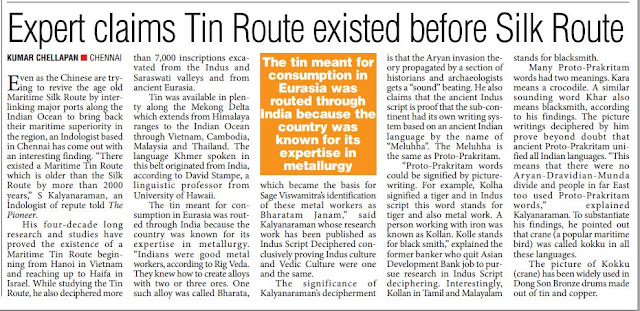EXPERT CLAIMS TIN ROUTE EXISTED BEFORE SILK ROUTE
Monday, 31 August 2015 | Kumar Chellappan | CHENNAI
Even as the Chinese are trying to revive the age old Maritime Silk Route by inter-linking major ports along the Indian Ocean to bring back their maritime superiority in the region, an Indologist based in Chennai has come out with an interesting finding. “There existed a Maritime Tin Route which is older than the Silk Route by more than 2000 years,” S Kalyanaraman, an Indologist of repute told The Pioneer.
His four-decade long research and studies have proved the existence of a Maritime Tin Route beginning from Hanoi in Vietnam and reaching up to Haifa in Israel. While studying the Tin Route, he also deciphered more than 7,000 inscriptions excavated from the Indus and Saraswati valleys and from ancient Eurasia.
Tin was available in plenty along the Mekong Delta which extends from Himalaya ranges to the Indian Ocean through Vietnam, Cambodia, Malaysia and Thailand. The language Khmer spoken in this belt originated from India, according to David Stampe, a linguistic professor from University of Hawaii.
The tin meant for consumption in Eurasia was routed through India because the country was known for its expertise in metallurgy. “Indians were good metal workers, according to Rig Veda. They knew how to create alloys with two or three ores. One such alloy was called Bharata, which became the basis for Sage Viswamitra’s identification of these metal workers as Bharatam Janam,” said Kalyanaraman whose research work has been published as Indus Script Deciphered conclusively proving Indus culture and Vedic Culture were one and the same.
The significance of Kalyanaraman’s decipherment is that the Aryan invasion theory propagated by a section of historians and archaeologists gets a “sound” beating. He also claims that the ancient Indus script is proof that the sub-continent had its own writing system based on an ancient Indian language by the name of “Meluhha”. The Meluhha is the same as Proto-Prakritam.
“Proto-Prakritam words could be signified by picture-writing. For example, Kolha signified a tiger and in Indus script this word stands for tiger and also metal work. A person working with iron was known as Kollan. Kolle stands for black smith,” explained the former banker who quit Asian Development Bank job to pursue research in Indus Script deciphering. Interestingly, Kollan in Tamil and Malayalam stands for blacksmith.
Many Proto-Prakritam words had two meanings. Kara means a crocodile. A similar sounding word Khar also means blacksmith, according to his findings. The picture writings deciphered by him prove beyond doubt that ancient Proto-Prakritam unified all Indian languages. “This means that there were no Aryan-Dravidian-Munda divide and people in far East too used Proto-Prakritam words,” explained Kalyanaraman. To substantiate his findings, he pointed out that crane (a popular maritime bird) was called kokku in all these languages.
The picture of Kokku (crane) has been widely used in Dong Son Bronze drums made out of tin and copper.http://www.dailypioneer.com/nation/expert-claims-tin-route-existed-before-silk-route.html

